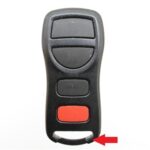Experiencing the frustration of a key fob that flawlessly unlocks your car doors but then refuses to start the engine? It’s a common car problem, and luckily, often points to a specific, sometimes easily addressed issue within your key fob itself. Before you rush to expensive replacements or dealership visits, let’s explore a diagnostic tip and potential DIY fix based on expert insights into key fob technology.
The first step in diagnosing this issue is surprisingly simple and utilizes a tool you likely already have in your pocket: your smartphone. This test focuses on verifying the radio frequency (RF) and infrared (IR) functionality of your key fob, crucial for communication with your car’s system.
To perform this test, activate your smartphone’s camera. Point the end of your key fob, specifically the red window or nose, directly at the camera lens. Now, press and hold either the lock or unlock button on your key fob while observing your phone screen. You’re looking for a small light emitting diode (LED) inside the key fob to illuminate. This LED is typically invisible to the naked eye but is readily detected by smartphone cameras.
If you observe the LED light up on your phone screen, this is good news! It indicates that the RF and infrared components of your key fob are functioning correctly. Furthermore, if your doors are indeed unlocking with this same key fob, it confirms that your car’s Electronic Ignition Switch (EIS) recognizes your key. The car’s system is designed to still allow starting even with a weak key fob battery, as the starting process relies on a different power source. You can even manually open the door using the mechanical key hidden inside your key fob assembly, further bypassing the battery-dependent functions for entry.
The starting process involves an ingenious system. When you insert your key fob into the ignition, an alternating current (AC) voltage is introduced to a primary transformer coil located within the EIS. Crucially, a secondary transformer coil resides inside your key fob. Through electromagnetic induction, current is transferred to this secondary coil within your key. This induced current is then rectified within the key fob and used to power the key’s functions, including the LED you observed earlier. Since your doors unlock and the LED test is positive, and especially if you have a spare key that does start the car, we can confidently assume the EIS in your dashboard is operating as expected.
This narrows down the potential problem area significantly, pointing towards a likely culprit: the secondary transformer coil inside your key fob. This coil is constructed from fine wire wrapped around a powdered iron core and, besides the battery, is often the heaviest component within the key. Due to its weight and relatively delicate soldering, this inductor coil is particularly susceptible to becoming dislodged or developing a poor solder connection, especially after the key fob has been dropped or subjected to impacts.
To investigate this potential issue, you’ll need a magnifying tool – ideally a 10X jeweler’s loupe. Carefully open your key fob casing and visually examine the circuit board. Locate the inductor coil, which is usually positioned in the “nose” area of the key fob. Using the loupe, meticulously inspect the solder joints connecting the inductor coil to the circuit board. Look for any signs of cracking, separation, or “cold” solder joints, which appear dull and uneven.
If you identify a suspect solder joint on the inductor coil, the good news is that this is often a repairable issue. However, it requires specialized equipment and skills. Surface mount soldering, the technique used for these tiny components, necessitates a surface mount soldering station and a steady hand. If you are comfortable with electronics repair and have the necessary tools, resoldering the inductor coil could restore your key fob’s starting functionality. If not, seeking assistance from a qualified electronics repair technician or a locksmith specializing in car key fobs would be the recommended next step.
While this guide focuses on a common cause related to the inductor coil, other issues can also prevent a key fob from starting your car. However, this diagnostic test and inspection provide a valuable starting point for troubleshooting and potentially resolving the “key fob unlocks but won’t start car” problem, potentially saving you time and money.
